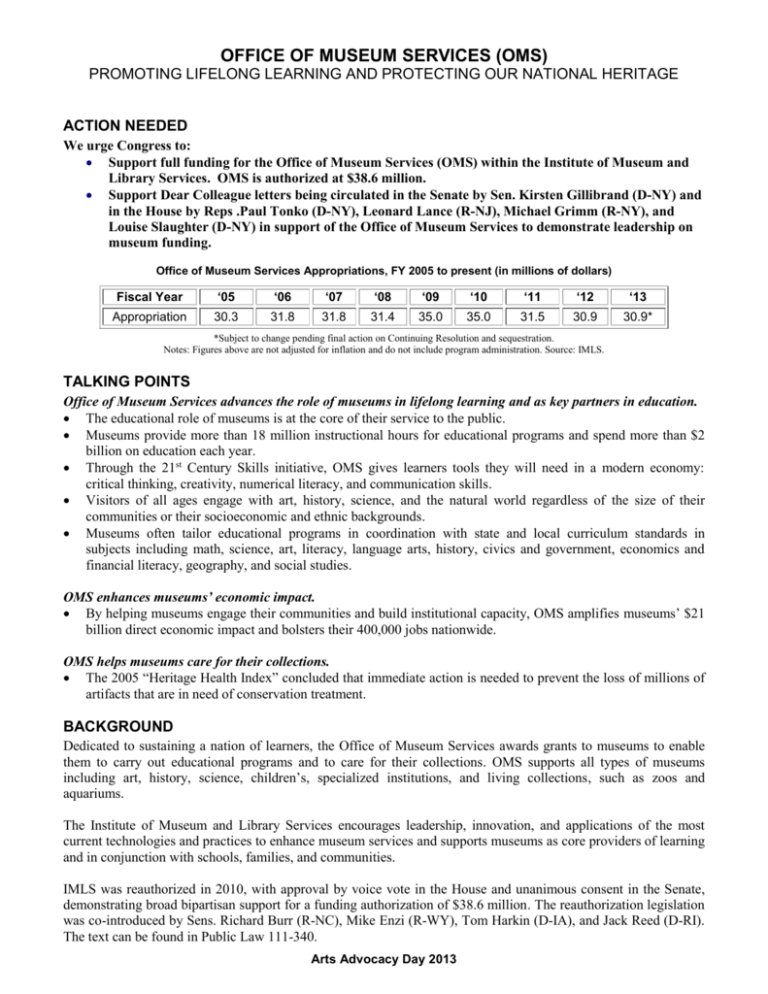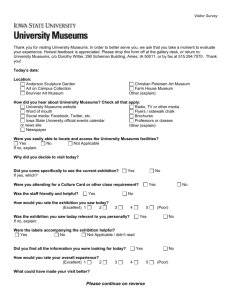PUBLIC SUPPORT FOR MUSEUMS: OMS
advertisement

OFFICE OF MUSEUM SERVICES (OMS) PROMOTING LIFELONG LEARNING AND PROTECTING OUR NATIONAL HERITAGE ACTION NEEDED We urge Congress to: Support full funding for the Office of Museum Services (OMS) within the Institute of Museum and Library Services. OMS is authorized at $38.6 million. Support Dear Colleague letters being circulated in the Senate by Sen. Kirsten Gillibrand (D-NY) and in the House by Reps .Paul Tonko (D-NY), Leonard Lance (R-NJ), Michael Grimm (R-NY), and Louise Slaughter (D-NY) in support of the Office of Museum Services to demonstrate leadership on museum funding. Office of Museum Services Appropriations, FY 2005 to present (in millions of dollars) Fiscal Year ‘05 ‘06 ‘07 ‘08 ‘09 ‘10 ‘11 ‘12 ‘13 Appropriation 30.3 31.8 31.8 31.4 35.0 35.0 31.5 30.9 30.9* *Subject to change pending final action on Continuing Resolution and sequestration. Notes: Figures above are not adjusted for inflation and do not include program administration. Source: IMLS. TALKING POINTS Office of Museum Services advances the role of museums in lifelong learning and as key partners in education. The educational role of museums is at the core of their service to the public. Museums provide more than 18 million instructional hours for educational programs and spend more than $2 billion on education each year. Through the 21st Century Skills initiative, OMS gives learners tools they will need in a modern economy: critical thinking, creativity, numerical literacy, and communication skills. Visitors of all ages engage with art, history, science, and the natural world regardless of the size of their communities or their socioeconomic and ethnic backgrounds. Museums often tailor educational programs in coordination with state and local curriculum standards in subjects including math, science, art, literacy, language arts, history, civics and government, economics and financial literacy, geography, and social studies. OMS enhances museums’ economic impact. By helping museums engage their communities and build institutional capacity, OMS amplifies museums’ $21 billion direct economic impact and bolsters their 400,000 jobs nationwide. OMS helps museums care for their collections. The 2005 “Heritage Health Index” concluded that immediate action is needed to prevent the loss of millions of artifacts that are in need of conservation treatment. BACKGROUND Dedicated to sustaining a nation of learners, the Office of Museum Services awards grants to museums to enable them to carry out educational programs and to care for their collections. OMS supports all types of museums including art, history, science, children’s, specialized institutions, and living collections, such as zoos and aquariums. The Institute of Museum and Library Services encourages leadership, innovation, and applications of the most current technologies and practices to enhance museum services and supports museums as core providers of learning and in conjunction with schools, families, and communities. IMLS was reauthorized in 2010, with approval by voice vote in the House and unanimous consent in the Senate, demonstrating broad bipartisan support for a funding authorization of $38.6 million. The reauthorization legislation was co-introduced by Sens. Richard Burr (R-NC), Mike Enzi (R-WY), Tom Harkin (D-IA), and Jack Reed (D-RI). The text can be found in Public Law 111-340. Arts Advocacy Day 2013 BACKGROUND (CONTINUED) During the past several years, the demand for museum educational services has grown; collections are at even more risk; and museum staff are in increasing need of professional development in education and technology. Many museums also report increased visitation during times of economic uncertainty, as families seek activities that are close to home, free or reasonably priced, educational, and safe. ABOUT MUSEUMS America’s more than 17,500 museums attract more than one billion visitors annually. Their collections consist of hundreds of millions of objects, artifacts, and living specimens in the fields of art, history, science, and specialized disciplines, needing constant care and protection. They hold these collections on behalf of the public Museums are also part of a robust nonprofit community working to address a wide range of our nation’s greatest challenges, from conducting medical research to hosting supervised visits for the family court system, and from creating energy efficient public buildings to collecting food for needy families. They tailor programming to meet community needs, working with military families, persons with memory loss, veterans, children with special needs, and those with limited English proficiency. More than one-third (35 percent) of U.S. museums are always free to the public, and more than 97 percent of the rest offer discounts, special fee schedules, or free admission days, according to American Alliance of Museums’ 2009 Museum Financial Information Survey. Museums provide trustworthy information on complex art, historical, and scientific issues in an era in which faulty, incomplete, or biased information is rampant. The credibility of museums stems, in part, from the solid foundation research and collections provide for exhibitions and educational programs. Teachers, students, and researchers participate in formal programs through online collections and exhibitions—and increasingly through social networking. Museums foster discussion and engagement around complex issues in contemporary society. Increasingly they provide a venue both for scholarly research and interpretation as well as for interactive activities connecting members both of the general public and specific audiences. They are offering a host of activities including lectures, performances, discussions, art-making, scientific experiments and web-based exhibitions, conversations, and blogs. Museums provide extensive services to America’s teachers and students. Their programs nearly always include professional development workshops and courses for teachers and curriculum-based educational visits. Museums can develop intensive partnerships with individual schools in which students undertake multiple visits, museum staff co-writes curriculum and lesson plans with teachers, and, in some cases, museums actually take responsibility for running charter schools. Art museums alone reach approximately 35,000 public, private, charter, parochial, magnet, and home schools in nearly every congressional district. Arts Advocacy Day 2013




